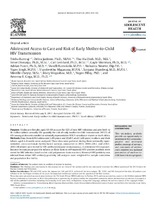| dc.contributor.author | Ramraj, Trisha | |
| dc.contributor.author | Jackson, Debra | |
| dc.contributor.author | Dinh, Thu-Ha | |
| dc.contributor.author | Olorunju, Steve | |
| dc.contributor.author | Lombard, Carl | |
| dc.contributor.author | Sherman, Gayle | |
| dc.date.accessioned | 2018-10-19T07:15:23Z | |
| dc.date.available | 2018-10-19T07:15:23Z | |
| dc.date.issued | 2017 | |
| dc.identifier.citation | Ramraj, T. et al. (2017). Adolescent access to care and risk of early mother-to-child HIV transmission. Journal of Adolescent Health, 62: 434–443 | en_US |
| dc.identifier.issn | 1054-139X | |
| dc.identifier.uri | https://doi.org/10.1016/j.jadohealth.2017.10.007 | |
| dc.identifier.uri | http://hdl.handle.net/10566/4141 | |
| dc.description.abstract | PURPOSE: Adolescent females aged 15–19 account for 62% of new HIV infections and give birth to
16 million infants annually. We quantify the risk of early mother-to-child transmission (MTCT) of
HIV among adolescents enrolled in nationally representative MTCT surveillance studies in South Africa.
METHODS: Data from 4,814 adolescent (≤19 years) and 25,453 adult (≥20 years) mothers and their
infants aged 4–8 weeks were analyzed. These data were gathered during three nationally representative,
cross-sectional, facility-based surveys, conducted in 2010, 2011–2012, and 2012–
2013. All infants were tested for HIV antibody (enzyme immunoassay), to determine HIV exposure.
Enzyme immunoassay-positive infants or those born to self-reported HIV-positive mothers were
tested for HIV infection (total nucleic acid polymerase chain reaction). Maternal HIV positivity was
inferred from infant HIV antibody positivity. All analyses were weighted for sample realization
and population live births.
RESULTS: Adolescent mothers, compared with adult mothers, have almost three times less planned
pregnancies 14.4% (95% confidence interval [CI]: 12.5–16.5) versus 43.9% (95% CI: 42.0–45.9) in
2010 and 15.2% (95% CI: 13.0–17.9) versus 42.8% (95% CI: 40.9–44.6) in 2012–2013 (p < .0001),
less prevention of MTCT uptake (odds ratio [OR] in favor of adult mothers = 3.36, 95% CI: 2.95–
3.83), and higher early MTCT (adjusted OR = 3.0, 95% CI: 1.1–8.0), respectively. Gestational age at
first antenatal care booking was the only significant predictor of early MTCT among adolescents.
CONCLUSIONS: Interventions that appeal to adolescents and initiate sexual and reproductive health
care early should be tested in low- and middle-income settings to reduce differential service uptake
and infant outcomes between adolescent and adult mothers. | en_US |
| dc.language.iso | en | en_US |
| dc.publisher | Elsevier | en_US |
| dc.rights | © 2017 Society for Adolescent Health and Medicine. This is an open access article under the CC
BY-NC-ND license (http://creativecommons.org/licenses/by-nc-nd/4.0/). | |
| dc.subject | Adolescent | en_US |
| dc.subject | Access to care | en_US |
| dc.subject | Early mother-to-child HIV transmission | en_US |
| dc.title | Adolescent access to care and risk of early mother-to-child HIV transmission | en_US |
| dc.type | Article | en_US |
| dc.privacy.showsubmitter | FALSE | |
| dc.status.ispeerreviewed | TRUE | |
| dc.description.accreditation | ISI | |

